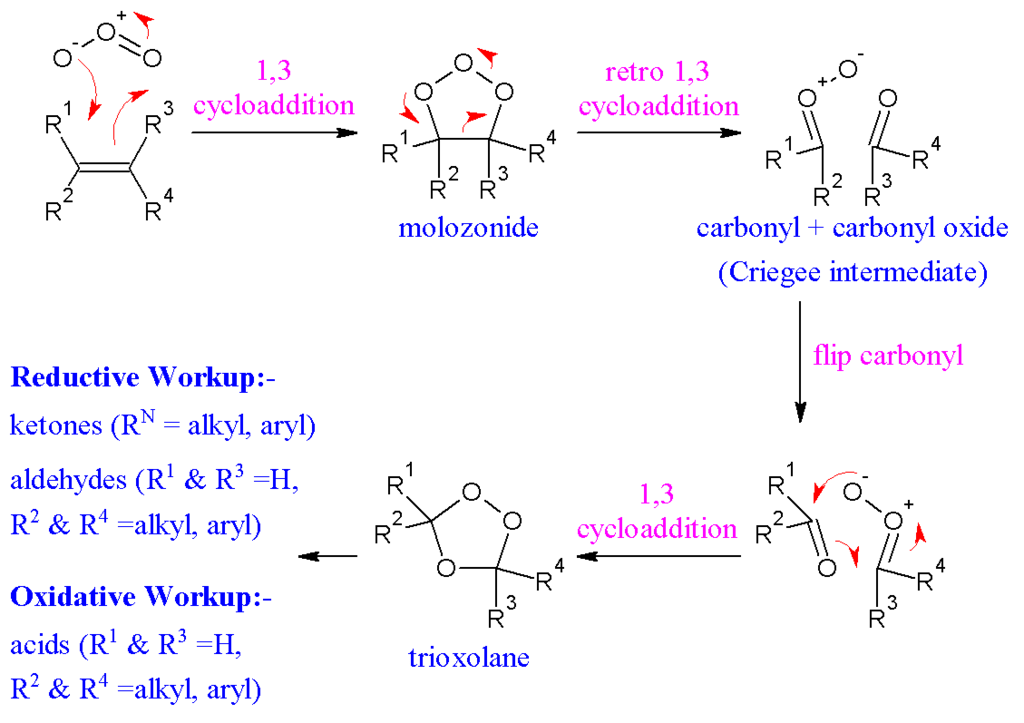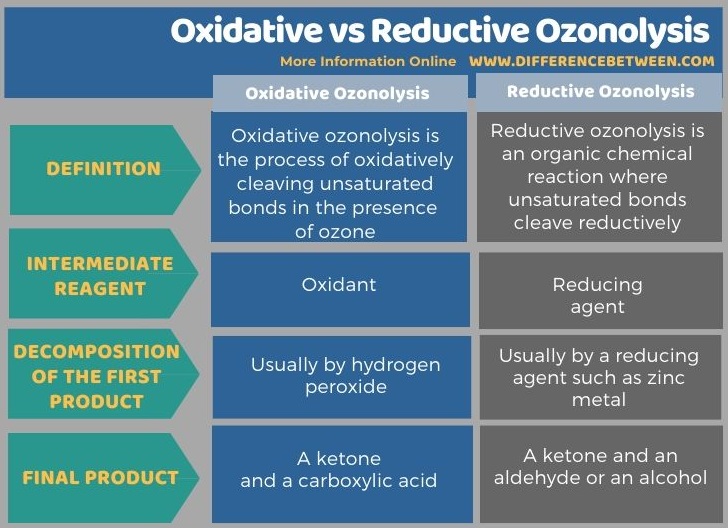Difference Between Oxidative and Reductive Ozonolysis
The key difference between oxidative and reductive ozonolysis is that oxidative ozonolysis gives carboxylic acids or ketones as products, whereas reductive ozonolysis gives either alcohols or carbonyl compounds.
Ozonolysis is an organic chemical reaction where unsaturated chemical bonds are cleaved using ozone. Here, the reactant molecules are alkenes, alkynes, or azo compounds. Depending on the starting material, the end product differs; e.g. if cleavage occurs in alkenes or alkynes, the end product is a carbonyl compound. Ozonolysis can be done in two ways as oxidative ozonolysis and reductive ozonolysis. However, the most common way is reductive ozonolysis.
CONTENTS
1. Overview and Key Difference
2. What is Oxidative Ozonolysis
3. What is Reductive Ozonolysis
4. Side by Side Comparison – Oxidative vs Reductive Ozonolysis in Tabular Form
5. Summary
What is Oxidative Ozonolysis?
Oxidative ozonolysis is the process of oxidatively cleaving unsaturated bonds in the presence of ozone. Ozone is a reactive allotrope of oxygen. And, this chemical reaction involves double bonds or triple bonds between covalently bonded carbon atoms in organic compounds. The double or triple bonds are replaced by oxygen, forming carbonyl compounds. Furthermore, the oxidative ozonolysis is important in identifying unknown alkenes.

Figure 01: Two Pathways of Ozonolysis
Moreover, ozonolysis can be found as a natural process. The end product of oxidative ozonolysis is a carboxylic acid. When considering the mechanism of oxidative ozonolysis, the first step is the syn addition of ozone to the unsaturated bond. There, the pi electrons in the unsaturated bond act as the nucleophile and ozone is the electrophile. When an electrophile attacks a compound, a second carbon-oxygen bond forms at the other end of the double bond. Thereafter, a rearrangement occurs to form a stable product. This product is an ozonide which then decomposes into a ketone and a carboxylic acid in the presence of hydrogen peroxide.
What is Reductive Ozonolysis?
Reductive ozonolysis is an organic chemical reaction where unsaturated bonds cleave reductively. This type of ozonolysis gives alcohols and carbonyl compounds as the final product. Although ozone is a good oxidant, the reductive process is also possible with ozonolysis. In this process, a reducing agent is added to the reaction mixture; e.g. zinc metal or dimethyl sulfide.
Usually, the reductive ozonolysis is the most common method of breaking down unsaturated bonds. In comparison to reductive ozonolysis, the ozonide formed in the first step is decomposed by the reducing agent (in the oxidative ozonolysis, this ozonide product is cleaved by hydrogen peroxide). When the starting material of reductive ozonolysis is an alkene, the products will be either an alcohol or and aldehyde forms along with a ketone.
What is the Difference Between Oxidative and Reductive Ozonolysis?
Ozonolysis is an organic chemical reaction. It can occur in two pathways as oxidative pathway and reductive pathway. Oxidative ozonolysis is the process of oxidatively cleaving unsaturated bonds in the presence of ozone. Reductive ozonolysis is an organic chemical reaction where unsaturated bonds cleave reductively. The key difference between oxidative and reductive ozonolysis is that oxidative ozonolysis gives carboxylic acids or ketones as products, whereas reductive ozonolysis gives either alcohols or carbonyl compounds.
The below infographic summarizes the difference between oxidative and reductive ozonolysis.

Summary – Oxidative vs Reductive Ozonolysis
Ozonolysis is an organic chemical reaction. It can occur in two pathways as oxidative pathway and reductive pathway. The key difference between oxidative and reductive ozonolysis is that oxidative ozonolysis gives carboxylic acids or ketones as products, whereas reductive ozonolysis gives either alcohols or carbonyl compounds.
Reference:
1. “12.12: Oxidative Cleavage: Ozonolysis.” Chemistry LibreTexts, Libretexts, 3 June 2019, Available here.
2. “Ozonolysis (Oxidative Workup).” Chemistryscore, 12 Feb. 2020, Available here.
3. “Ozonolysis.” Wikipedia, Wikimedia Foundation, 7 Mar. 2020, Available here.
Image Courtesy:
1. “Ozonolysis-2” By Ozonolysis.png: Chemistorgederivative work: Chemistorge (talk) – Ozonolysis.png (CC BY 2.5) via Commons Wikimedia
ncG1vNJzZmivp6x7pbXFn5yrnZ6YsqOx07CcnqZemLyue8OinZ%2Bdopq7pLGMm5ytr5Wau26716KbmqyZq7Jurc2dZKudlKqwtbXVnmSosp%2BjvK3F0qKqaA%3D%3D